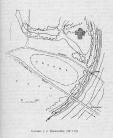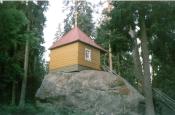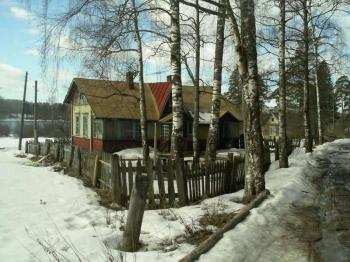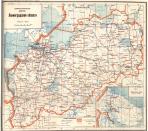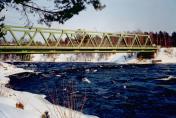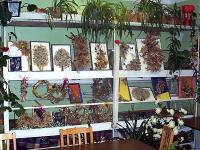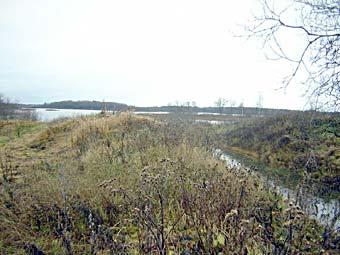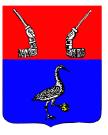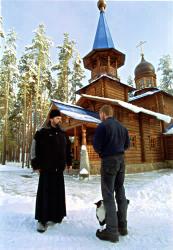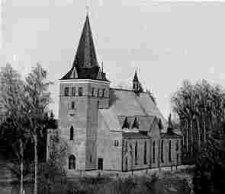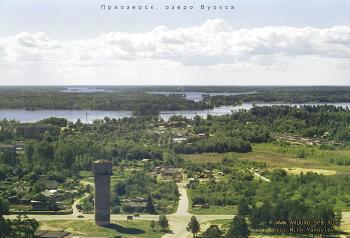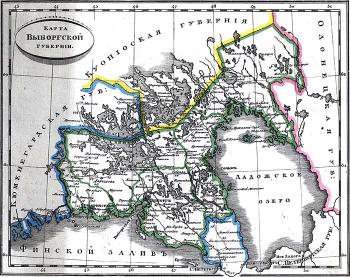|
hidden
|
Ancient settlements (selishche)
Selishches, remains of unfortified settlements, discovering according to the presence of the culture lay and withdrawn material. The search of ancient settlements is embarrassed for lack of external indications. More then 120 ancient settlements... more
|
|
|
|
hidden
|
Burial grounds of the Karelian people.
Burial grounds of the Karelians ( chronicle Korela, ancestors of the modern Korelians/Karyala) are concentrated in the north-western Ladoga Lake region (Priozersk district, joining districts of Karelia). There are known funeral monuments of the... more
|
|
|
|
hidden
|
Children Art Schools
CHILDREN’S ARTS SCHOOLS (CAS). In the last years Children’s Musical Schools (CMS) and Children’s Painting Schools (CPS) have had a growing tendency for unification into Children’s Arts Schools (CAS). By 2007 the Leningrad oblast had had 104 CAS,... more
|
|
|
|
hidden
|
Cult (worship) stones
Cult stones. The worship of cult stones was registered in all northern part of the East Europe including Baltic countries and Scandinavia. Track-stones, with deep image of a human foot track, are wide presented. Those images are sometimes... more
|
|
|
|
hidden
|
Ethnic groups if the Leningrad Oblast
Ethnic communities of the Leningrad Oblast. The settled communities of people historically formed on the certain territory, having the common features of culture and self-consciousness expressed in the native name are called an ethnic community (or... more
|
|
|
|
hidden
|
Finland
FINLAND, country in Northern Europe. Borders Sweden, Norway, the RF (Murmansk Oblast, Republic of Karelia, Leningrad Oblast.) Located on the coasts of the Gulf of Bothnia and Gulf of Finland, Baltic Sea. Area: 338,000 sq. km (abt. 10% being inland... more
|
|
|
|
hidden
|
Finns
Finns (old use - Chukhnas, their native name is Suomalaiset) is an ethnic community which is a part of the population of the Leningrad Oblast. In the world there are more than 5 million Finns. They are the main population of Finland (4,6 million... more
|
|
|
|
hidden
|
"Karlsky Peresheyek" ("The Karelian Isthmus"), a national park
Karlsky Peresheyek ("The Karelian Isthmus") is a national park. It is located in the territory of the Vsevolozhsk, Vyborg and Priozersk districts of the Leningrad Oblast. It occupies the area of 25 thousand hectares. It was founded with the decision... more
|
|
|
|
hidden
|
Kuznechnoye, urban settlement
KUZNECHNOYE, urban settlement in Priozersk District. Population: 5,200. Located in the north-east of the Karelian Isthmus, at the Lake Ladoga coast, near the borders of the Republic of Karelia and Finland. The name was given in 1948. From 1961, K.... more
|
|
|
|
hidden
|
Leningrad Oblast, the
LENINGRAD OBLAST, subject territory of RF. Area: 83,900 sq. Km (max. Extension from west to east: 446 km, north to south: 325 km.) Population (as of 2002): 1,669,000. The Oblast borders Pskov and Novgorod Oblasts in the south, Vologda Oblast in the... more
|
|
|
|
hidden
|
Losevo, settlement
LOSEVO (Finnish Kiviniemi before 1948), a settlement in Priozersk District. Located in the area known as Kiviniemi (“stone promontory”, Russian version: Kamenka) on the left (northern) bank of the arm connecting the Vuoksa River with Lake... more
|
|
|
|
hidden
|
Melnikovo, settlement
MELNIKOVO (Finnish Räisälä before 1948), a settlement in Priozersk District. Population: 2100. Located on the banks of the northern branch of the Vuoksa River. In 1948, the settlement was renamed first Otradnoye, and then Melnikovo, in memory of... more
|
|
|
|
hidden
|
Michurinskoye, settlement
MICHURINSKOYE (Finnish Valkjarvi = “white lake” before 1948), a settlement in Priozersk District. Population: 2100. Located on the shore of Lake Michurinskoye (former Valkjarvi.) In 1948 it was successively renamed Belozerskoye, Krivko (in memory of... more
|
|
|
|
hidden
|
Municipal Unions
MUNICIPAL ENTITIES, urban or rural (may comprise several united rural localities, such as a volost in Leningrad Oblast) – a settlement, municipal district, or urban area (and an intra-city area of a federal level city), where local government is... more
|
|
|
hidden
|
Natural monuments
The natural monument is the category of the specially protected natural areas and in the international classification they have status of the natural monument. They are a small area, which include important natural objects (terrain feature, groves... more
|
|
|
|
hidden
|
Population
Population. According to the census of 2002 in the Leningrad Oblast there were 1669,205 thousand people; according to the estimate made on 1 July 2005 there were 1647,6 thousand people including the town dwellers numbering 1093,9 thousand people... more
|
|
|
hidden
|
Priozersk District coat of arms and flag, the
The Priozersk District's coat of arms and flag are the official approved symbols of the Municipal Union “Priozerskiy municipalniy rayon” (The Priozersk District) (the coat of arms was approved with the decision of the Soviet of People's Deputies of... more
|
|
|
|
hidden
|
Reserves
Reserves (Sanctuaries in the international classification) . This is category of special protected natural territories which founded for protection or restoration the components of nature and for maintenance the common ecological balance. Some... more
|
|
|
hidden
|
Resettlements of the 1945 - 1950s
Resettlements of the 1945 - 1950s were migrations which were caused by political (eviction of some categories of citizens who were considered as unreliable, including the activities for cleaning up the frontier) and economical (the necessity of... more
|
|
|
hidden
|
Sapyornoye, settlement
SAPERNOYE (Finnish Venaja Valkjarvi / “Russian White Lake” before 1948), a settlement in Priozersk District. Population: 3300. Located at Lake Sapernoye (former Beloye / Valkjarvi). Settlements in the place of S. were already known in the mid-16th... more
|
|
|
|
hidden
|
Sosnovo, settlement
SOSNOVO (Finnish Rautu before 1948), a settlement in Priozersk District. Population: 6000. Located south of Lake Razdolinskoye (Finnish Leihinkylanjarvi) at Sosnovo railway station of the St. Petersburg-Priozersk branch. The toponym Rautu originates... more
|
|
|
|
hidden
|
Vuoksa Lake
VUOKSA, lake. Located in Priozersk District. Part of the Vuoksa River system (northern branch.) The largest lake in the Karelian Isthmus. Area: 92.6 sq. km (108 sq. km including the islands’ area.) Max. depth: 25 m, the shallowest part is the... more
|
|
|
|
hidden
|
Vuoksa River, the
VUOKSA, river. It originates in Lake Saimaa (Finland), and flows in Vyborg and Priozersk Districts of Leningrad Oblast. Length: 156 km (of which, 143 km in Leningrad Oblast.). It is subdivided into two arms, the northern and the southern one. The... more
|
|
|
|
hidden
|
Vyborg Gubernia, the
VYBORG GUBERNIA, historic adm. and territorial unit of Russia and Finland. It occupied the northern part of the Karelian Isthmus, Northern Coast of Ladoga, south-east of the current Finland. In the Middle Ages, V. G. was the places of ethnogenesis... more
|
|
|
|
hidden
|
Zaporozhskoye, settlement
ZAPOROZHSKOYE (Finnish Metsapirtti = “wood hut” before 1948), a settlement in Priozersk District. Population: 1900. In the 1499/1500 scribe roll of Vodskaya Pyatina it is mentioned as “Na cheperte” village. In 1792, a Lutheran church was built... more
|
|
|



